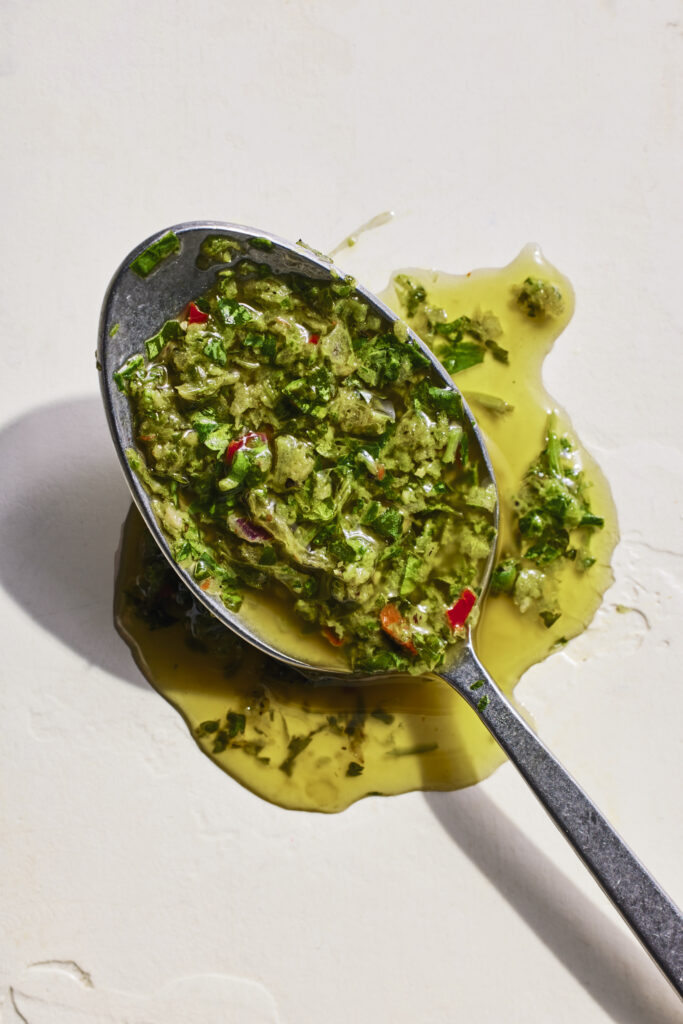The Mediterranean diet is full of healthy fruits and veggies, savory proteins, and unique and interesting recipes. Being a diet comprised of many different cultures, it’s no wonder there are many dishes from many countries that you’ll encounter when eating in Mediterranean restaurants and doing Mediterranean cooking.
One popular dish is a Mediterranean pesto called Schug. Schug is a savory green pesto sauce originating in Yemeni cuisine and is now enjoyed all around the Mediterranean and Middle East. The taste comes from small ingredients packed with flavor to create a palette comparable to a Middle-Eastern salsa verde or an Argentinian chimichurri with a Persian twist.
This spicy sauce can be prepared in a variety of ways and with different ingredients depending on personal preference. Today, we want to talk about how we like to prepare our Schug at Luna Grill.
This fiery and fresh sauce with a taste of cilantro, parsley, and garlic is an absolute favorite at Luna Grill. It’s fantastic on different proteins like chicken, Bistro beef, and salmon, but it brings incredible flavor to any dish.
What Is Schug Made Of?
So what are the ingredients that make Schug the special sauce that it is? Let’s talk about some of the core and optional ingredients.
Garlic
One of the most popular staple ingredients across different cuisines is garlic. We can never get enough of it. This immune system-boosting little bulb is core to creating a flavorful Schug. For our recipe, you’ll need one tablespoon of minced garlic.
Parsley
A leafy green with an earthy and peppery taste, this plant is key in many different types of pestos, and Schug is no different. You’ll want to ensure you have a bunch of parsley handy when making your homemade Schug. Our recipe uses two ounces of parsley, which is about one bunch cut just above the wire band.
Cilantro
This zesty plant finds its way to the core of many different cuisines worldwide, and Mediterranean cuisine is no different. This citrusy and fresh leafy green pairs perfectly with the earthy spice of parsley. Cilantro is the star of the show when it comes to Schug, so we call for about six ounces of Cilantro (3 bunches cut just above the wire band).
Green Onion
Onions of any type always add a good biting flavor to a sauce. We prefer the lightness of the green onion when creating Schug. Our recipe calls for two ounces of green onion, about four stalks.
Olive Oil
It wouldn’t be a Mediterranean sauce if we didn’t include olive oil. After all, olive oil is central to all Mediterranean and Middle Eastern cooking. This healthy oil brings flavor and a smooth texture to this sauce. Our recipe calls for one and a half cups of this amber oil.
Lemon Juice
Add a splash of citrus to your Schug with lemon juice. While this juice is considered optional, we find it’s the perfect addition to the other flavors found within your Schug. Not to mention, it’s a natural preservative! It keeps your Schug fresher and more flavorful for longer.
In our Schug recipe, we recommend about three tablespoons of fresh lemon juice.
Spices
There are a few spices that are core to Schug. Salt and pepper, of course, are going to be crucial. There are others that are the perfect way to step up the flavor of your Schug, and those would be the savory eastern spices of cardamom, coriander, and cumin.
We also recommend adding red pepper flakes to your Schug for some extra spice. A good thing to note: Red pepper flakes will bloom the longer they sit in your sauce and your sauce will be spicier the next day. Depending on your heat tolerance, you can add more or less.
Peppers
This ingredient is entirely optional or can replace red pepper flakes in your Schug. Adding green and red peppers to your Schug, like jalapenos, is a great way to add heat along with freshness and flavor.
How To Make Schug: Our Recipe
Ingredients:
- 1 TB Freshly Minced Garlic
- 6 oz. Rough Chop Cilantro (about three bunches)
- 2 oz. Rough Chop Flat leaf Parsley (about one bunch)
- 2 oz. Rough Chop Green Onion (about four stems)
- 3 Tablespoons Fresh Lemon Juice
- 1 1/2 cups Extra Virgin Olive Oil
- 2 tsp Red Pepper Flakes
- 1 tsp Salt
- 1 tsp Black Pepper
- 1/2 tsp of Ground Cardamom
- 1/4 tsp of Ground Cumin
- 1/4 tsp of Ground Coriander
How to Prepare
Preparing Schug is probably the easiest part of the recipe. All it requires is prepping your ingredients and then mixing them together. To prepare Schug, the only appliances you’ll need are a food processor.
Step 1: Rinse and clean your leafy greens.
Step 2: Put all of your ingredients into a food processor:
Step 3: Blend until smooth. Scrape the sides of the processor and repeat the blend.
That’s it! This will create about two cups of creamy, spicy, delicious Schug. If you chill your Schug overnight, it will be even zestier the next day!
What Can I Eat With Schug?
There’s no wrong or right way to eat Schug. You can practically pair it with any Mediterranean meal. Let’s talk about some of our favorite ways to eat Schug.
Drizzled on Hummus
Nothing is quite as classic and savory as a hummus spread with a drizzle of Schug on top. We recommend eating this with pita bread or crunchy veggies like carrots and cucumbers. This makes for a great appetizer or a mid-day snack break.
Add Zest to a Salad
Salads are so versatile and come in all shapes and sizes. Whether you’re enjoying a modern Greek salad or a classic house salad, who doesn’t like to add a little zest to their dish? Schug is a great way to add an extra layer of depth and spice to a classic salad.
Sandwich Spread
Just like you can with any pesto, you can add Schug to your favorite sandwiches. We love adding Schug to veggie-filled sandwiches with other ingredients like cucumber, tomato, sprouts, spinach, and a savory protein of your choice, like chicken.
Marinade for Protein
Schug brings out the flavors of Mediterranean seasoned proteins like chicken, grilled salmon, and bistro beef. We recommend trying Schug on any one of our entree platters, not to mention they come with some fantastic sides for pairing.
Paired With Falafel Wrap
Schug is a great sauce to balance the muted, earthy flavors of falafel with the zesty, spicy flavors within the Schug itself. There’s no better way to enjoy Schug than on a falafel wrap, where the creamy flavor of the tzatziki will balance perfectly with the spices of the Schug, and all of the veggies will add a crispy freshness and texture.
In a Gyro Wrap
The flavor of savory, unique gyro meat is one that you’ll definitely want to pair with Schug. Especially if you’re a spice fan, we recommend trying this with any type of Mediterranean wrap, particularly our gyro wrap. So many classic Middle Eastern flavors come together on a gyro wrap topped with Schug.
With Basmati Rice
Sometimes simple doesn’t have to mean plain. A great way to zest up your side of rice is with some sauce, and Schug does this perfectly.
The Versatile and Flavorful Mediterranean Pesto: Schug
Whether this is your first time hearing about this Mediterranean masterpiece or you’ve been a fan for a while, it’s never too early or late to get familiar with Schug. This Yemeni sauce has been popular in the Mediterranean and the Middle East for centuries. It’s versatile and pairs well with so many other classic dishes in the Mediterranean diet, like hummus, couscous, and tabouli.
Best of all, it’s so easy to make at home. Once you have all your ingredients, all you have to do is blend. Not to mention, the ingredients required are affordable and easily accessible, with the most notable being cilantro, parsley, and olive oil.
If you haven’t tried Schug before, you definitely should put it on your culinary bucket list. It’s a rich sauce that you’ll find to become a staple in your household. If you’ve never tried out your hand at making the sauce yourself, we hope this guide leaves you feeling confident in taking on that fun challenge. And of course, you can always try out our version at your local Luna Grill!
Sources:
Garlic – Health Encyclopedia | University of Rochester Medical Center
The Secrets of the Mediterranean Diet. Does [Only] Olive Oil Matter? | PMC



